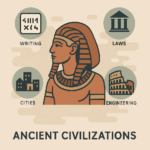The Ancient Egyptian Civilization is one of the oldest and most influential cultures in human history. It lasted for over 3,000 years, beginning around 3100 BCE and lasting until 332 BCE, when Alexander the Great conquered Egypt. During this time, the Egyptians developed a complex society with remarkable achievements in areas like architecture, art, religion, and science.
Egypt is located in northeastern Africa, mostly along the banks of the Nile River, which was the lifeblood of the civilization. The Nile provided water, transportation, and fertile soil for agriculture. This made Egypt one of the most powerful and stable civilizations of the ancient world. The Egyptians believed that the Nile was a gift from the gods, and its yearly flooding made farming possible, allowing them to grow crops like wheat, barley, and flax.

Pharaohs, the kings of Egypt, were considered divine rulers. They were seen as gods on Earth who ensured the welfare and protection of the country. The most famous pharaohs include Tutankhamun, Ramses II, and Cleopatra. Pharaohs built impressive structures like the Great Pyramids of Giza and the Sphinx, which are still considered wonders of the ancient world. These structures were tombs for the pharaohs, as the Egyptians believed in an afterlife, where the soul would need a body and possessions to thrive.
Religion was at the center of Egyptian life. They believed in many gods and goddesses, each of whom controlled different aspects of life. For example, Ra, the sun god, was the most important deity, and Osiris, the god of the afterlife, played a major role in the Egyptian belief in life after death. Egyptians believed that by following religious practices and rituals, they could ensure a good life in the afterlife.
The social structure in Egypt was hierarchical, meaning that society was organized in layers, with the pharaoh at the top. Below him were the nobles, priests, and scribes. These people had important roles in government, religion, and record-keeping. Farmers, laborers, and craftsmen made up the majority of the population. They worked the land and built the temples and pyramids but were often treated poorly compared to the higher classes.
The Egyptians were also skilled in writing. They developed a form of writing called hieroglyphs, which was a system of pictures and symbols used to record information. They used hieroglyphs on the walls of tombs, temples, and monuments. This writing system helped preserve Egyptian culture for thousands of years. Another important development was the papyrus, a type of paper made from the papyrus plant, which allowed Egyptians to create scrolls and write more easily.
In terms of science and technology, the Egyptians made many advances. They understood mathematics and engineering well enough to construct the pyramids and other monumental buildings. They also made important contributions to medicine, particularly in the field of surgery and anatomy. The Egyptians even developed a calendar based on the movement of the stars and the Nile River, which helped them predict the flooding of the Nile.
One of the most famous aspects of ancient Egyptian culture is its art and architecture. The Egyptians created stunning works of art that decorated tombs and temples. They painted murals, created statues, and designed jewelry with intricate patterns. Their architecture, particularly the pyramids, temples, and tombs, showcased their advanced engineering skills. The Pyramids of Giza, built during the Old Kingdom, are some of the most well-known and lasting symbols of ancient Egypt.
The Egyptians also developed a system of government that lasted for much of their history. Egypt was divided into regions called nomes, each governed by a nomarch (local ruler). The central government, led by the pharaoh, made decisions about the military, laws, and economy. The Egyptians had a well-organized bureaucracy to handle these responsibilities. As a result, Egypt became one of the most stable and powerful civilizations of its time.
While Egypt’s history spanned many dynasties, the civilization went through periods of rise and decline. At its peak, Egypt controlled vast territories, but over time, it faced invasions from foreign powers like the Hyksos, Assyrians, Persians, and eventually the Romans. Despite these invasions, Egypt’s culture, knowledge, and achievements continued to influence other civilizations for centuries.
Summary:
The Ancient Egyptian Civilization was one of the world’s oldest and most influential, lasting over 3,000 years. Located along the Nile River, it was built around agriculture, religion, and powerful rulers called pharaohs. The Egyptians were known for their monumental architecture, such as the Pyramids, and their advancements in writing, science, and medicine. Society was structured hierarchically, with the pharaoh at the top. Egyptians believed in many gods and the afterlife, which influenced their culture. While Egypt faced invasions and eventual decline, its achievements in art, engineering, and governance shaped the development of civilizations for centuries.











